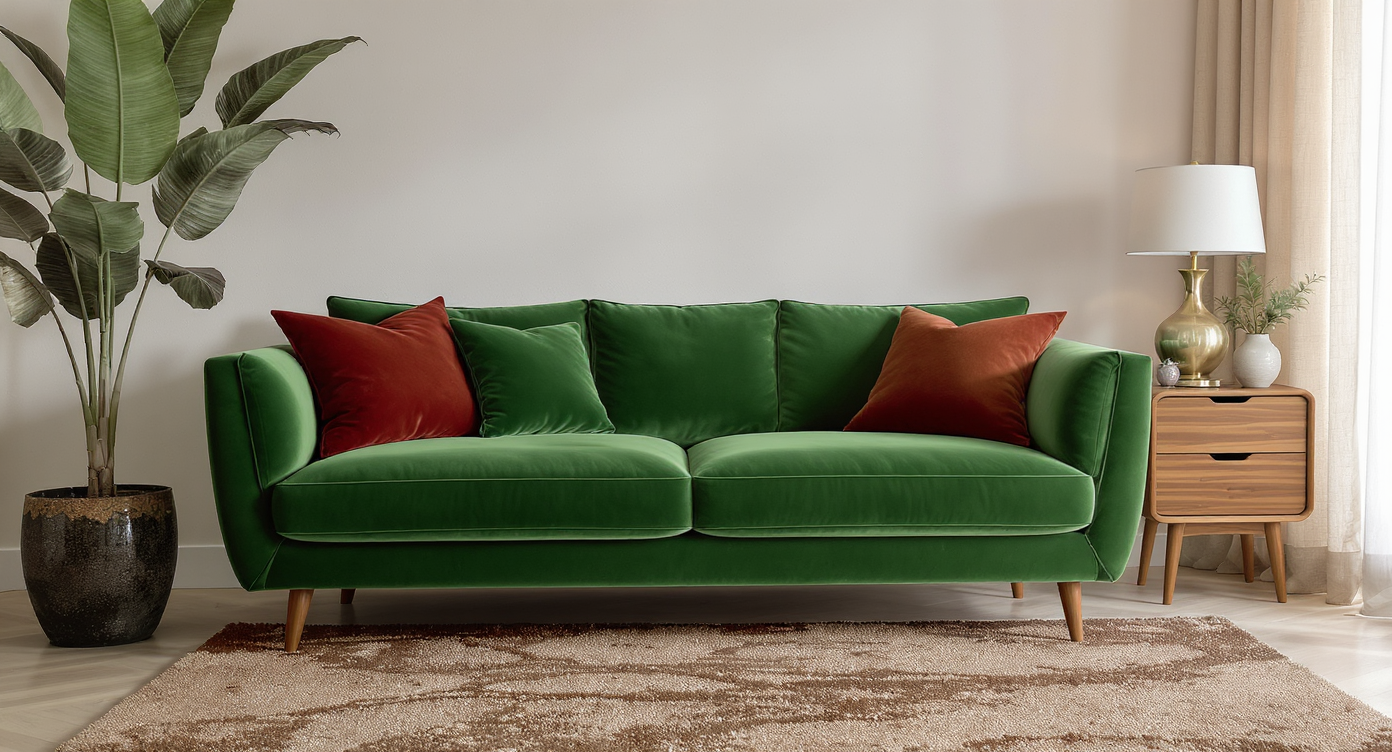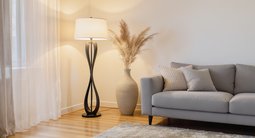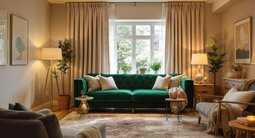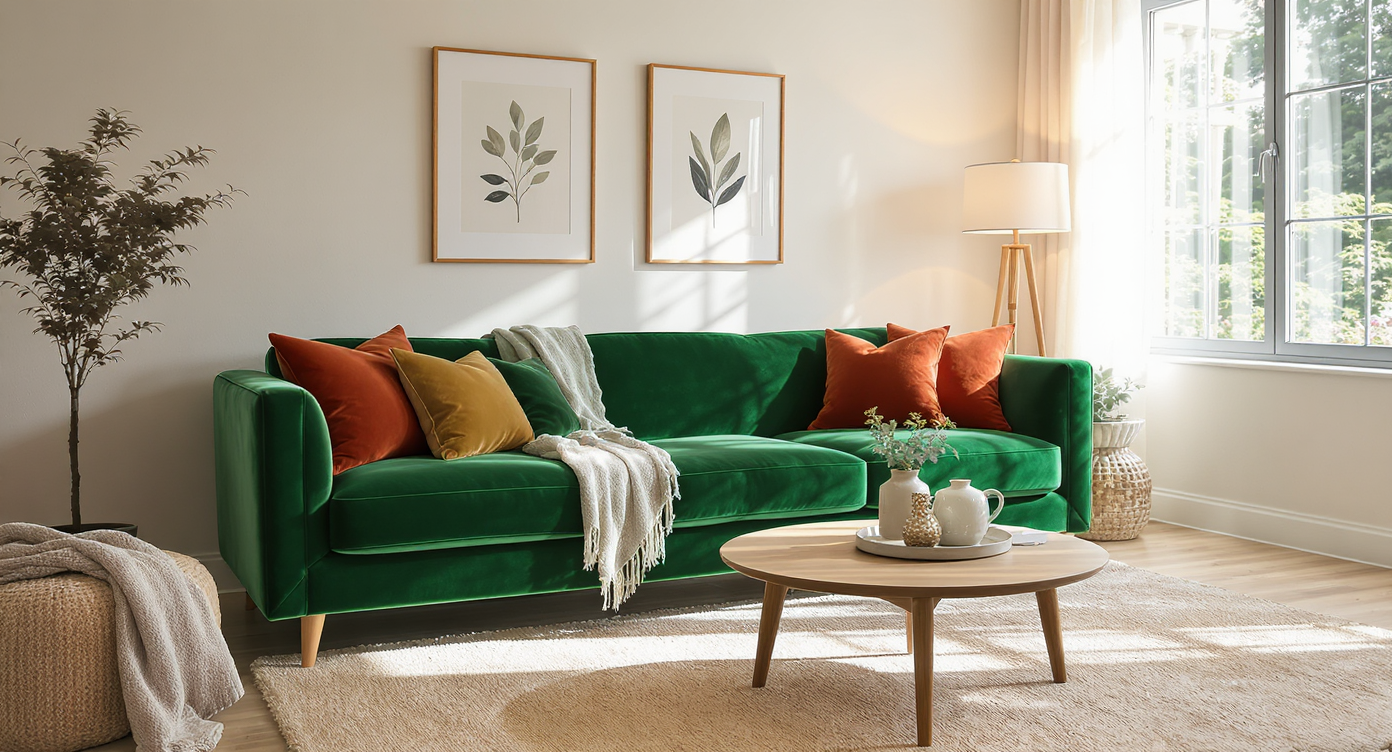TL;DR
A bold green couch works beautifully when you repeat the green at least twice elsewhere and balance it with warm textures and complementary colors. Use the 60-30-10 color rule, anchor with a right-sized rug, and pull in plants, curtains, and pillows to create a cohesive palette that feels collected, not chaotic.
Why a green couch can absolutely work

Styling tips for a bold green sofa: pair with warm reds, natural wood, and textured accents for balance and depth.
Green couch. Two words that send some people into a panic and others into a happy dance. If you ordered a green sofa expecting muted sage and ended up with saturated forest, don’t worry. The right styling can make that "very green" read as rich, classic, and grounded in your living room color palette.
Here’s the thing: green is one of the most versatile upholstery colors. It behaves like a near-neutral in nature-inspired rooms and plays beautifully with red, rust, gold, and wood. The key is control — repeat the green, anchor it with texture, and let lighting do some heavy lifting. Below is a clear plan to make your green sofa look intentional and layered, even if it surprised you out of the box.
Core strategy: how to style a bold green couch
A green couch feels cohesive when its color repeats in at least two other places — think curtains, pillows, artwork, or plants.
- Use the 60-30-10 color rule. Let your room’s dominant color take 60 percent (walls/rug), secondary at 30 percent (sofa/curtains/chairs), and accents at 10 percent (pillows/art/metals). Designers often advise keeping the sofa in the 30 percent band so it reads intentional, not lonely.
- Repeat the green. Add one tall plant (5 to 7 feet), a pair of green-toned pillows (22 to 24 inches for fuller sofas), or linen drapery in a similar undertone. Even a single art print with deep green can pull the palette together.
- Lean into complementary warmth. Green’s complement is red, which includes rust, terracotta, and cranberry. A rust or brick-red rug or throw will make the green sing without feeling like the holidays.
- Mind undertones. If your sofa skews cool emerald, pair with cool whites, brass, and walnut. If it’s olive, bring in camel leather, aged brass, and cream. Matching undertone is the fastest route to harmony.
- Right-size the rug. At minimum, front legs of the sofa should sit on the rug; for a fuller look, aim for 8 to 12 inches of rug visible around the seating area. A rug that’s too small makes bold color feel louder.
- Upgrade the lighting. Overhead fixtures should follow this rule of thumb: room length + width (in feet) ≈ fixture diameter (in inches). Warm bulbs (2700–3000K) soften saturated green instantly.
- Window treatments that tie it all. Curtains look best hung high and wide: 4 to 6 inches above the frame (or to the ceiling) and 8 to 12 inches past each side. Deep green or wheat-gold drapery can bridge the sofa and your existing warm tones.
- One user insight: Many homeowners find that a single whimsical accent — a sculptural footstool or vintage chandelier — keeps a traditional green sofa from feeling too formal.
Alt text idea: Deep green velvet sofa with rust rug, brass lamp, and tall fiddle-leaf fig; Caption: Repeating green and warming with brass creates cohesion.
Anecdote
A couple thought their new green sofa clashed with a rust rug. After adding a wheat throw, two cream pillows, and a brass lamp, the palette looked classic instead of Christmassy — proof that undertones and texture matter more than the exact shade.
Common mistakes to avoid with a green sofa
Bold color fails when there’s no repetition, the rug is undersized, or undertones clash across textiles and paint.
- Over-matching greens. Buying five identical green pillows won’t help. Use two pieces in the sofa’s family and mix in contrast (wheat, rust, cream) for depth.
- Ignoring undertones. Cool emerald next to yellow-beige walls can fight. If repainting, experts recommend a wall color with an LRV in the 40–60 range and a subtle green or warm neutral undertone.
- Skimping on scale. Too many small pillows make a big sofa look busier. Choose fewer, larger pillows (22–24 inches) and one lumbar to simplify.
- Flat lighting. Overhead-only lighting emphasizes shadows and saturation. Add two to three light sources at different heights: table lamps, a floor lamp, and dimmers.
- Pattern overload. If your rug, curtains, and pillows are all high-contrast patterns, the eye has nowhere to rest. Keep one hero pattern and let the rest be textured solids.
Pro tips designers swear by
For quick cohesion, repeat the sofa color in three zones: vertical (curtains/art), horizontal (rug/pillows), and organic (plants).
- Plants are palette glue. A single tall plant or a trio of medium plants mirrors the green without adding more fabric. Try a 36-inch floor planter to fill corners.
- Curate metals. Aged brass and antique gold warm green instantly; black iron adds contrast and modernity. Pick one dominant metal and repeat it two to three times.
- Rug strategy. If your rug skews red/orange, keep pillows lighter: oatmeal, wheat, or camel. If the rug is neutral, introduce a patterned pillow that includes the sofa’s green plus one warm tone.
- Chandelier swagger. In traditional rooms, a whimsical or slightly decadent fixture stops the palette from feeling staid. Think pleated shades, milk glass, or a vintage-inspired brass lantern.
- Fade control. Vibrant upholstery near windows will mellow over time. Designers often advise UV-filtering liners on curtains and rotating cushions every few months to even patina.
- Paint, if needed. Soft olive-gray, muted taupe, or cream with a green undertone can bridge a saturated sofa and warm woods. Sample swatches at least 24 by 24 inches and view in daylight and at night.
Alt text idea: Green sofa styled with cream pillows, wheat throw, and botanical art; Caption: The 60-30-10 rule keeps bold color balanced.
Anecdotes & real rooms that got it right
Repeating the green, lightening the pillows, and adjusting window treatments turned a "too green" sofa into a showpiece in three different homes.
- Surprised by saturation. One homeowner expected sage but received emerald. They swapped dark pillows for two wheat cushions and a patterned lumbar, added a tall plant by the window, and suddenly the sofa felt curated, not neon.
- The curtain fix. Another home had one lone curtain panel for glare. They replaced it with full, lined green drapery hung high and wide. The room gained symmetry, the sofa looked intentional, and afternoon TV no longer battled sunlight.
- Rug tie-in. A couple with a rust Persian-style rug thought the green was fighting it. A camel throw and a brass pharmacy lamp later, the red/green complement looked luxe, not Christmas-y.
- Whimsy wins. A family leaned into character with a playful leather animal footstool and a small vintage chandelier. The green couch felt less formal, more inviting — and they started hosting more game nights.
Visualization Scenario
Imagine the first evening after a quick refresh: high-and-wide green curtains, a warm brass floor lamp, and a camel throw softening the sofa’s saturation. The room hums with layered color, and the green reads as intentional — a comfortable, character-rich anchor rather than a shock of color.
FAQ: your green couch questions, answered
What colors go with a green couch?
Green pairs with complementary reds (rust, terracotta), warm neutrals (wheat, camel, cream), and metals like aged brass. Experts recommend repeating the green twice elsewhere to make it feel intentional.
How do I tone down a bright green sofa?
Use warm, textured neutrals — think camel throw, cream pillows, and linen curtains — plus warm bulbs (2700–3000K) to soften saturation. A rust or brick-red accent will balance the green without feeling festive.
What rug works best with a green sofa?
Persian-style rugs with rust and gold, or neutral jutes layered under patterned wool, anchor a green sofa well. Ensure the rug is large enough for the sofa’s front legs to sit on it.
What curtains go with a green couch?
Deep green, wheat-gold, or natural linen curtains harmonize with a green couch; hang them 4–6 inches above the frame and 8–12 inches beyond each side for a tailored look.
Is a green sofa a neutral?
In nature-inspired palettes, a deep green sofa behaves like a near-neutral, especially when layered with wood tones, brass, and botanical elements. Designers often advise treating it as the room’s secondary color.
Tools & inspiration
- Room mockups: Try pillow, curtain, and rug combinations with ReimagineHome to see the palette before you commit.
- Paint sampling: Test 24×24-inch swatches near the sofa and check both daylight and evening light.
- Lighting audit: Add at least three light sources — ambient, task, and accent — on dimmers.
Alt text idea: Bold green sofa with high-and-wide curtains and layered lighting; Caption: Lighting temperature and drapery scale mellow saturated color.
Picture this
Late afternoon. Lamps glow warm against wheat pillows and a rust throw. A tall plant softens the corner, green curtains frame the view, and the sofa that once felt "too green" now looks like it’s always belonged — the quiet star of a layered, cozy room.
Tags: Green Couch, Green Sofa, Living Room, Furniture Placement, Color Scheme, Sectional, Rug Size, Warm Neutrals
Category: Room Decorating and Design Ideas
Bring the room together, not down
A green couch works when you echo it, warm it, and scale it right. Repeat the green twice, use the 60-30-10 rule, hang curtains high and wide, and let plants and brass do some of the styling for you. Designers often note that once the palette is balanced, a vibrant sofa becomes the room’s favorite seat, not its loudest voice.
Want to test layouts, pillows, curtains, or paint virtually? Upload a photo and try ReimagineHome to visualize options before you lift a finger.




.svg)

.svg)



.png)